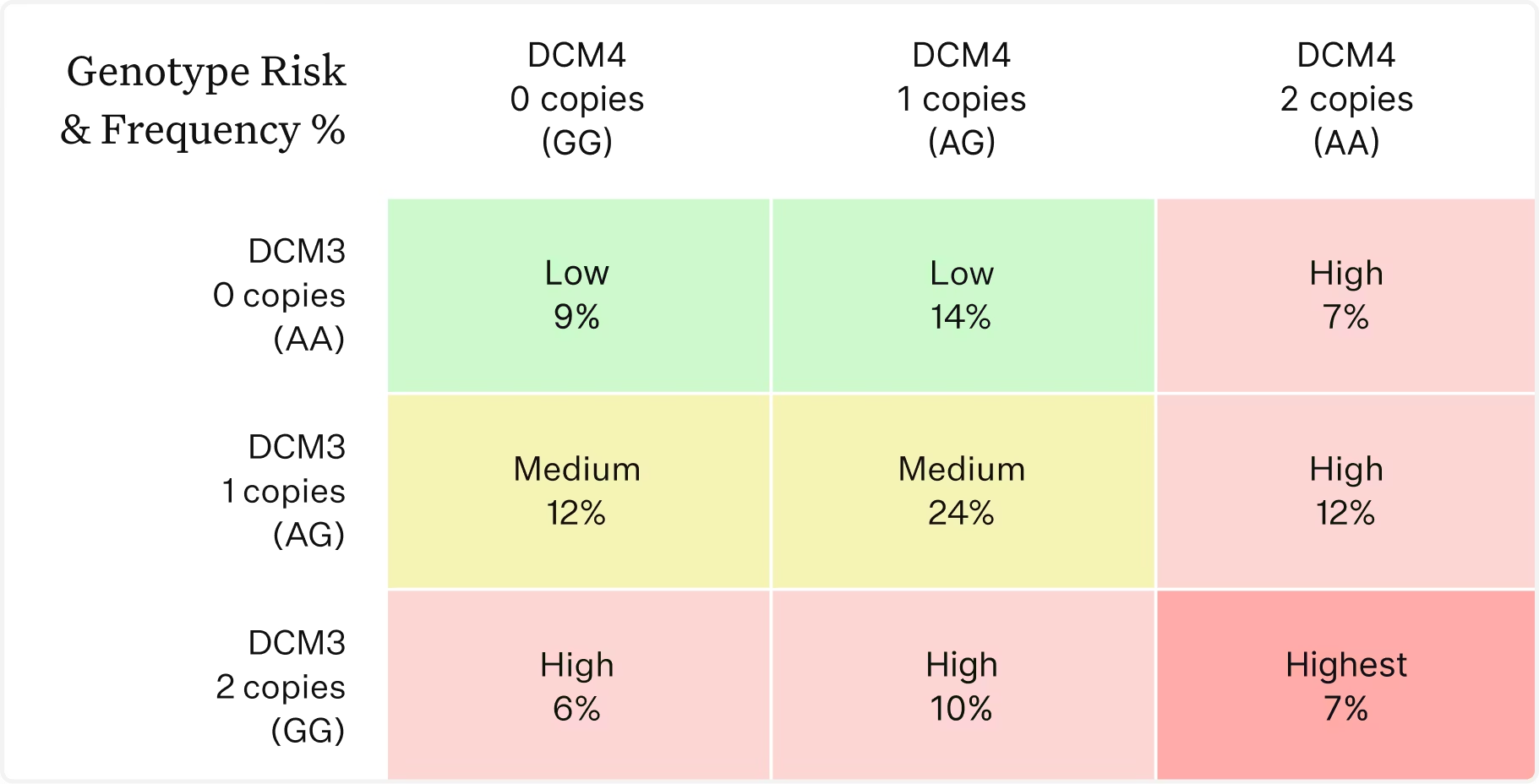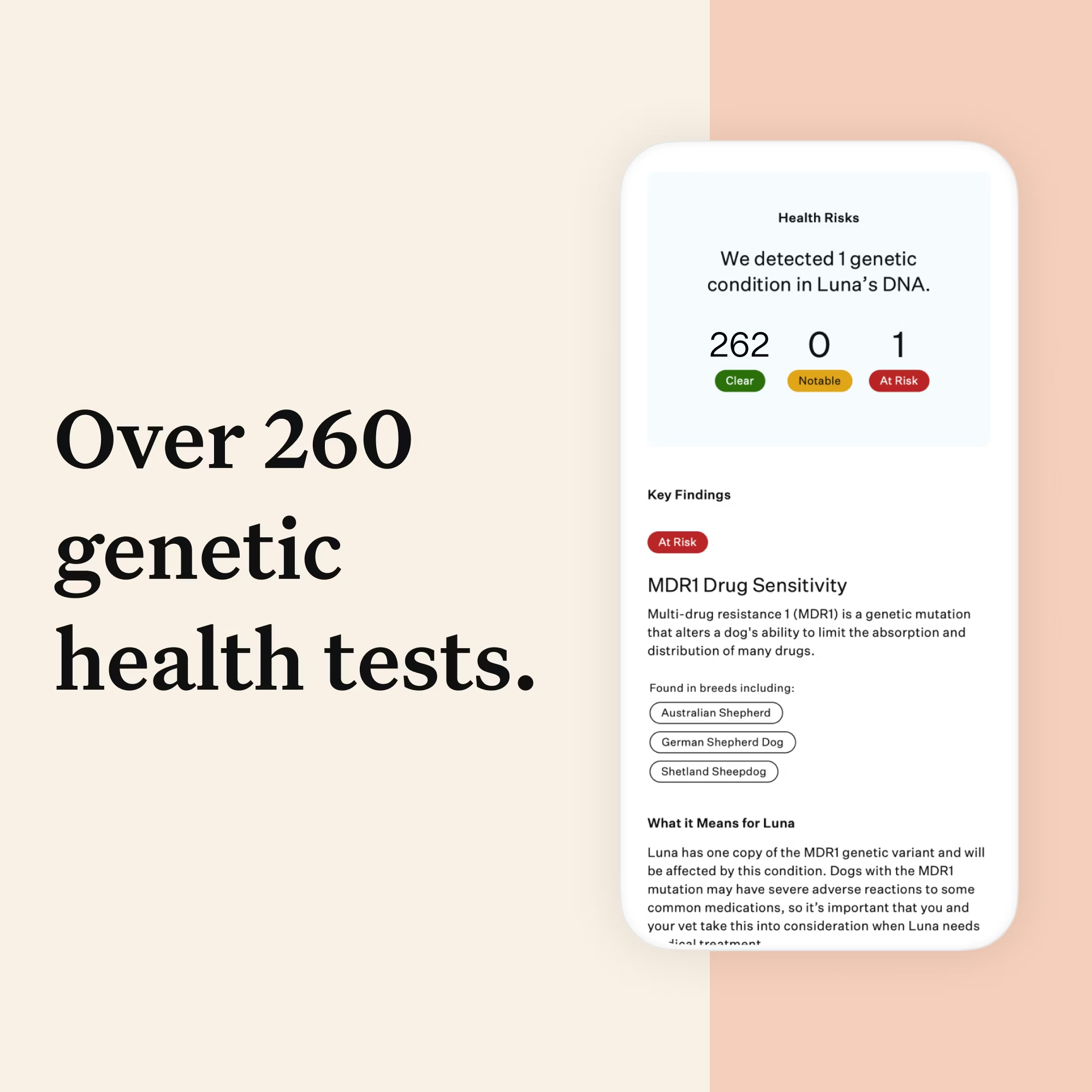What is Dilated Cardiomyopathy (DCM)
DCM is a severe condition in which the walls of the heart become thin and weak, leading to heart enlargement and eventual heart failure due to a decreased ability to pump blood. It is the second most common heart disease in dogs and is well recognized within the Doberman Pinscher community. The condition typically presents in middle- to older-aged dogs, often past the time of breeding, which makes research and the ability to screen for this condition crucial for the health of future generations.
Symptoms of DCM can vary between individuals. Some dogs may show exercise intolerance, persistent coughing, breathing difficulties, fainting, or swelling of the abdomen due to fluid build up (known as ascites). Other dogs may only experience heart arrhythmias (irregular heartbeats) which can cause sudden death without other symptoms.
Development of DCM is a complex disorder that can be influenced by hereditary and non-hereditary factors–many of which remain to be uncovered. The DCM risk variants tested by Wisdom are just a few of the considerations for understanding a dog’s unique predisposition to developing dilated cardiomyopathy.
What to expect if your dog is at risk
Though understanding of DCM and treatment options continue to progress, dilated cardiomyopathy remains a serious and fatal disorder. Because it is an incurable and progressive condition, the focus of treatment is on managing how the disorder progresses and optimizing quality of life.
Dogs at risk of developing DCM should be examined at least once a year by a veterinarian and, if possible, a veterinary cardiologist. Imaging techniques such as an echocardiogram (heart ultrasound) may be used to understand the heart’s current health status. Holter monitoring, a portable electrocardiogram (ECG), may be used for asymptomatic dogs since arrhythmias can be the first–or only–clinical sign.
While there is no cure, dogs who develop DCM can receive therapy to control arrhythmias, improve the heart’s function and manage congestive heart failure. In addition, working with a veterinarian on appropriate diet and exercise plans can help improve quality of life. And, because stress can worsen clinical signs, keeping dogs as calm and stress-free as possible can be beneficial.
Unfortunately, the general prognosis for Dobermans who develop DCM is considered poor with these individuals experiencing significantly shortened lifespans. Although, dogs who respond well to medical therapies can experience improved short-term prognosis.
Scientific insights: DCM3 & DCM4
Wisdom’s team of expert scientists have partnered with the University of Helsinki, located in Helsinki, Finland, in their efforts to study Doberman DCM. And the 20-year-long undertaking has led to the largest scientific publication on the topic to date!
Using genome-wide association studies, the newly published research has identified two genetic risk variants for Dobermans diagnosed with DCM. The DCM3 variant (chr5:53,109,178) is considered a minor risk factor, while the DCM4 variant (chr5:60,531,090) is considered a major risk factor. While together they work in an additive fashion, meaning the number (and combination) of risk variants influence the overall risk level, the individual variants still follow basic genetic inheritance patterns.
DCM3 is likely to follow an autosomal dominant mode of inheritance, where one or two copies of the individual variant increases risk of developing the condition. And DCM4 is proposed to follow an autosomal recessive mode of inheritance, where–on its own–two copies of the variant increases risk. The Wisdom tests for DCM3 and DCM4 are what is known as linkage testing. Linkage testing does not directly test for the causal variant but provides a prediction based on nearby associated markers in the DNA.
Dogs sampled within the study, and those later used for further validation, were from European Doberman populations. Specifically: Germany, Finland, Slovenia, Sweden and the Netherlands. The study found no association between DCM and either the PDK4 variant (DCM1) or the TTN variant (DCM2) previously identified as risk factors for DCM in the American Doberman population. Thus, further research is needed to understand the current risk profile in Dobermans from other regions, including America, in relation to previously identified and newly identified variants. But, given the unbiased discovery approach and the newly identified risk variants’ strong association with DCM in the breed, it is anticipated that the new variants will comport increased risk in the US population. However, further research is needed for this to be scientifically proven.
For more information on DCM1 and DCM2 testing through Wisdom, check out our blog: Doberman DCM1 & DCM2. Additionally, please note the four tested variants do not explain all occurrences of DCM in the breed, suggesting additional genetic factors may be involved.
Explanation of the two DCM genotypes
DCM3: minor risk variant, chr5:53,109,178
0 copies (AA)
1 copies (AG)
2 copies (GG)
DCM4: major risk variant, chr5:60,531,090
0 copies (GG)
1 copies (AG)
2 copies (AA)
When placed together, the genotype is written as (DCM3) / (DCM4).
When calculating risk from two variants there are nine possible outcomes. Dogs with zero copies of both risk variants are considered lowest risk (AA/GG), while dogs with two copies of each risk variant are at highest risk (GG/AA).
It is significant to note that even Dobermans within the lowest risk group can still go on to develop DCM. However, they are at far lower risk than those in higher risk categories. Additionally, please be mindful that as research into understanding risk factors for developing Doberman DCM continues, our understanding of these risk variants may also change. If interested in aiding this research, continue to the bottom of this post for information on a study regarding North American Dobermans.
Breakdown of risk by genotype
Low risk: 0-50%
Medium risk: 51-75%
High risk: 76-99%
Highest risk: 100%

Summary of risk
Each risk level corresponds with the following genetic combinations:
Low risk: AA/GG, AA/AG
Medium risk: AG/GG, AG/AG
High risk: AA/AA, AG/AA, GG/GG, GG/AG
Highest risk: GG/AA
Even in dogs clear of both DCM3 and DCM4, a low risk remains for being diagnosed with DCM. This is because the development of DCM is a complex disorder that is likely both polygenic (influenced by multiple genes) and multifactorial (influenced by genetic and non-genetic factors).
How common are DCM3 and DCM4
Unfortunately, the two risk variants are common in the Doberman population. In an independent sample set of 1,200 Dobermans collected by Wisdom Panel, the frequency of DCM3 is 46% and the frequency of DCM4 is 50%.
The following list shows the frequency percentage of Doberman in each risk group:
AA/GG: 9%, Low Risk
AA/AG: 14%, Low Risk
AA/AA: 7%, High Risk
AG/GG: 2%, Medium Risk
AG/AG: 24%, Medium Risk
AG/AA: 12%, High Risk
GG/GG: 6%, High Risk
GG/AG: 10%, High Risk
GG/AA: 7%, Highest Risk

Breeding recommendations
Given the frequency distribution, it is essential that breeding away from the risk variants is done gradually to maintain genetic diversity within the Doberman breed. It would be damaging to the breed population to try to solve the issue in a single generation.
Therefore, it is recommended to select mating pairs based on genotypes so that High (AA/AA, AG/AA, GG/GG, and GG/AG) and–particularly–Highest (GG/AA) risk genotypes are avoided in the offspring. To ensure that none of the resulting puppies are in the highest risk category, it is important that one of the parents has zero copies for the major risk variant, DCM4 (GG). Subsequent generations should be tested before choosing breeding pairs to responsibly manage the condition in the breed and gradually work towards decreasing its incidence.
Most importantly, please keep in mind the complex development of Doberman DCM is still undergoing research, and our understanding of risk profiles may change as new breakthroughs occur. Additionally, the findings shared in this post should not discourage using imported lines to maintain breed diversity.
For more detailed information on mating outcomes in dogs with DCM3 and DCM4, visit our breeder site.
Next steps in genetic research
Wisdom’s team of scientists are excited to announce the next phase of research is already beginning for North American Dobermans. We are seeking participants for a study to validate the association of DCM3 and DCM4 with the development of DCM in Doberman from North American family lines. Additionally, the study will allow a review of risk association between the four described DCM risk variants in the given Doberman population. For more information on the study, including inclusion criteria and the application process, please visit our DCM in Dobermans page.




